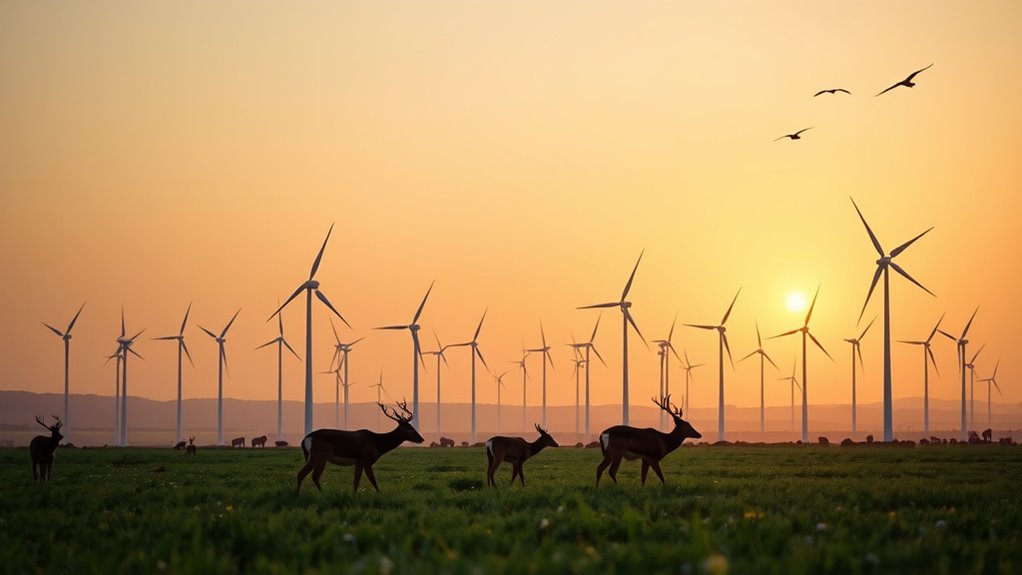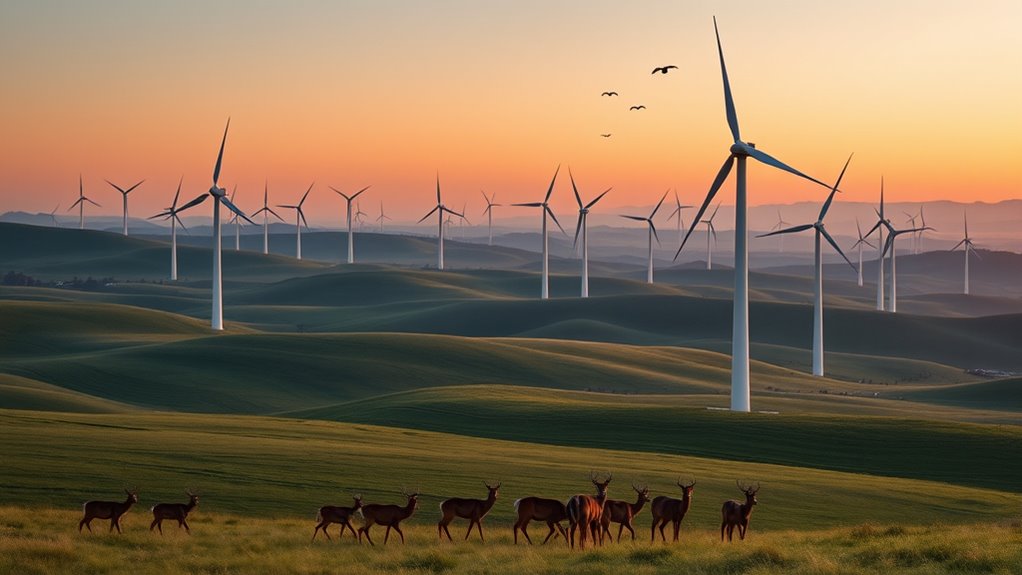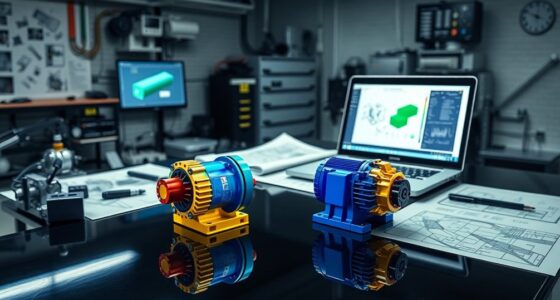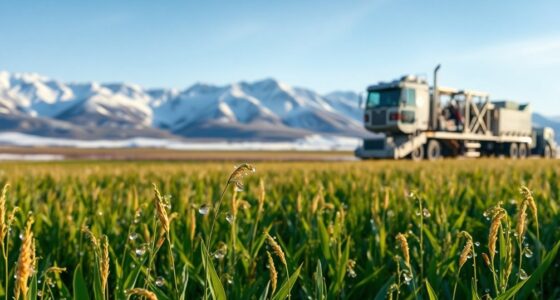Wind farms are essential for reducing greenhouse gases, but they can harm wildlife through bird collisions and habitat fragmentation. To balance energy needs with ecology, experts suggest careful siting, environmental assessments, and innovative technologies like bird detection systems. These strategies help protect sensitive species and ecosystems while supporting renewable energy. If you want to understand how sustainable solutions can achieve this balance, there’s more to explore that can guide responsible wind farm development.
Key Takeaways
- Proper siting and environmental assessments help minimize wildlife collisions and habitat disruption from wind farms.
- Technological innovations like radar systems enable real-time turbine shutdowns to protect migrating birds.
- Habitat fragmentation caused by wind farm development can be mitigated through ecological planning and habitat restoration.
- Monitoring and adaptive management ensure ongoing mitigation efforts effectively balance energy production with wildlife conservation.
- Integrating ecological considerations into wind energy planning promotes sustainable development that protects biodiversity.

Have you ever wondered how wind farms impact local wildlife? As communities push for cleaner energy sources, wind turbines have become a common sight, but their effects on animals, especially birds and other wildlife, deserve close attention. One of the primary concerns is avian collisions, where birds accidentally fly into turbine blades. These collisions can cause injuries or fatalities, particularly for species that migrate or hunt near wind farms. Birds often don’t see the spinning blades or misjudge their speed, especially during poor weather conditions or at night when many species are less active. While researchers have documented these incidents, the overall impact varies based on location, turbine design, and bird behavior.
Wind farms can cause bird injuries and fatalities through collisions with turbine blades.
In addition to direct collisions, wind farms can cause habitat fragmentation, which disrupts the natural environment birds and other animals rely on. When large areas are cleared for turbine installation and access roads, it fragments the habitat, making it harder for wildlife to find food, breed, or migrate freely. Fragmented habitats can lead to reduced biodiversity, as some species may avoid the disturbed areas altogether, while others struggle to adapt to the new landscape. This disruption can have cascading effects on local ecosystems, impacting predator-prey relationships and plant pollination cycles. Moreover, the integration of emerging technologies such as AI-powered monitoring systems is helping to better assess and mitigate these impacts over time.
You might think that these issues are unavoidable, but many strategies aim to mitigate their effects. For example, siting turbines away from major migratory routes or key breeding areas can substantially reduce avian collisions. Developers often conduct thorough environmental assessments before construction, aiming to identify and avoid sensitive habitats. Technological innovations are also in progress, like radar systems that detect bird movements and temporarily shut down turbines when large flocks are nearby. These measures help balance the need for renewable energy with wildlife conservation.
It’s important to recognize that wind farms are essential for reducing greenhouse gases and combating climate change. However, integrating ecological concerns into planning processes ensures that we minimize harm to wildlife. By carefully selecting locations, employing smarter technology, and monitoring impacts over time, we can create a more sustainable coexistence. As you consider the expansion of wind energy, understanding these delicate ecological balances helps you appreciate the efforts to protect wildlife while advancing clean energy solutions. Ultimately, thoughtful planning and innovation can help us harness wind power without sacrificing the health of our planet’s diverse ecosystems.
Frequently Asked Questions
How Do Wind Farms Impact Local Bird Migration Patterns?
You might wonder how wind farms impact bird migration. They can cause migratory disruption by altering avian navigation, making it harder for birds to follow traditional routes. Turbine blades are a threat, as birds may collide with them, especially during low visibility or poor weather. To minimize this, you should consider location and timing, helping balance renewable energy development with protecting migratory birds and maintaining their natural navigation patterns.
What Wildlife Species Are Most at Risk From Wind Turbines?
Like a shadow over sunlight, wind turbines pose risks to certain wildlife. You should know that species like birds and bats are most at risk due to habitat fragmentation and limited species adaptation. They often collide with blades or get caught in turbulence. These threats highlight how turbines can disrupt migration, nesting, and feeding. Protecting these species requires careful siting and mitigation strategies to balance energy needs with ecological preservation.
Are There Effective Measures to Mitigate Turbine-Related Animal Deaths?
You can implement effective measures to reduce turbine-related animal deaths by focusing on habitat enhancement and noise reduction. Installing radar systems and adjusting turbine operation during peak animal activity helps, while habitat enhancement attracts wildlife away from turbines. Noise reduction technologies also lessen disturbance, making turbines less risky. These strategies work together to protect vulnerable species while allowing wind energy to supply clean power.
How Do Wind Farm Locations Consider Ecological Sensitivity?
Think of choosing wind farm sites as carefully planting a garden—you want to safeguard the delicate plants, just like preserving habitats. You consider ecological sensitivity by avoiding areas with critical habitat or migration routes. Habitat preservation takes priority, minimizing disruption. Noise pollution is also managed to prevent disturbing wildlife. By balancing these factors, you guarantee energy needs are met without sacrificing nature’s harmony, like tending a garden with care and respect.
Can Wildlife Corridors Coexist With Wind Farm Developments?
You can design wildlife corridors that coexist with wind farm developments by carefully planning corridor routes to minimize habitat fragmentation. Using effective corridor design, you guarantee animals have safe pathways around turbines, reducing collision risks. By integrating ecological data into wind farm planning, you create a balance that promotes both renewable energy goals and wildlife conservation, allowing habitats and corridors to thrive alongside sustainable energy infrastructure.
Conclusion
As you consider the future of wind farms, remember that every decision you make impacts wildlife in ways you might not yet fully understand. Will advancements in technology finally tip the balance, or will unforeseen consequences emerge? The path ahead remains uncertain, and your choices could shape how we protect both our planet’s energy needs and its delicate ecosystems. Stay engaged, stay vigilant—because the story of sustainable energy and wildlife is still unfolding, and you’re part of it.










